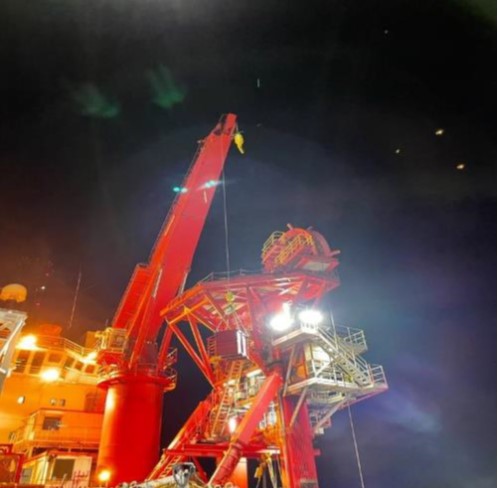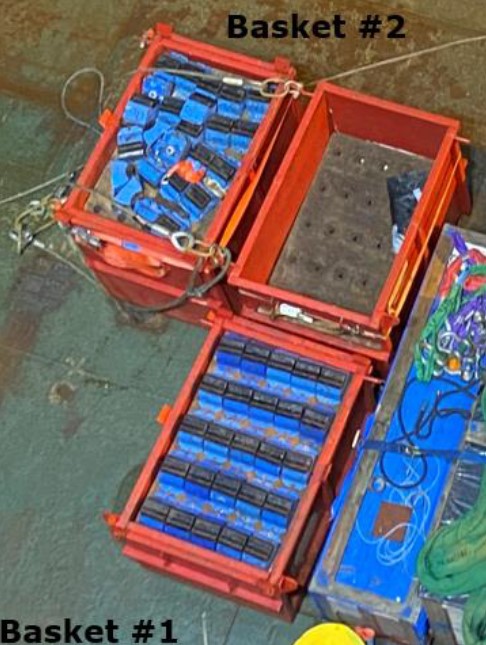Dropped object during lifting operations
What happened
A part weighing 8.5kg fell over 15m from a pipelay tower to deck. The incident occurred when tensioner pads were being changed out on a Tiltable Lay System (TLS). The discarded pads were packed into two dedicated tensioner pad baskets on the TLS tower for transfer back to deck. The crane operator lifted a first basket and placed it in the landing zone on deck. When lifting the second basket, a higher boom angle was needed in order to clear the TLS. As the basket cleared the TLS, it started swaying. This movement was amplified after the basket hit the crane boom, causing a single tensioner pad to fall from the basket down to the main deck.
The displaced tensioner pad fell approximately 15 to 18 meters. There was no-one in the area at the time, and the area of the crane lift path had been barriered off as an exclusion zone.


What went wrong?
Our members’ findings were:
- The dropped object (tensioner pad) resulted from the excessive movement of an unsecured load;
- The change-out of tensioner pads was considered a “routine lift” and did not require a designated Lift Plan (with a specific slew path identified);
- The operation took place at night and the sea conditions were not apparent to the crane operator or banksman when they started the lift;
- Risk assessments
- Although a risk assessment for routine lifts had been reviewed at the Toolbox Talk (TBT), the risk assessment specific to tensioner pad change-out (which includes the lifting of the baskets) was not reviewed before starting the task;
- The risk assessment specific to the tensioner pad changeout was inadequate – it did not specify a cover for the tensioner basket, nor did it take into account the effect of the sea state/swell on the swing of the load and how this should be factored into the chosen slew path;
- The locking mechanism on the side door of the tensioner pad basket was found to be inadequate and could have quite easily sprung open.
Lessons learned
- An alternate slew path with a high boom angle would have avoided the basket striking the crane and cause increased swing;
- A cover or net fitted to the basket would have prevented the pad being displaced.
Actions
- Check all lifting appliances, supports and baskets to ensure they are fit for purpose including that doors have secure locking mechanisms;
- Never overfill and always secure the load in open top containers;
- Crane operators and banksman should work together to identify the best possible routes for moving equipment around the vessel taking sea state/swell into consideration;
- The vessel bridge should always be consulted before starting lifting operations, to ensure the sea state and vessel movements are within limits and where practical a heading to reduce vessel movement is taken.
Members may wish to review:
Safety Event
Published: 16 June 2021
Download: IMCA SF 17/21
IMCA Safety Flashes
Submit a Report
IMCA Safety Flashes summarise key safety matters and incidents, allowing lessons to be more easily learnt for the benefit of all. The effectiveness of the IMCA Safety Flash system depends on Members sharing information and so avoiding repeat incidents. Please consider adding [email protected] to your internal distribution list for safety alerts or manually submitting information on incidents you consider may be relevant. All information is anonymised or sanitised, as appropriate.
IMCA’s store terms and conditions (https://www.imca-int.com/legal-notices/terms/) apply to all downloads from IMCA’s website, including this document.
IMCA makes every effort to ensure the accuracy and reliability of the data contained in the documents it publishes, but IMCA shall not be liable for any guidance and/or recommendation and/or statement herein contained. The information contained in this document does not fulfil or replace any individual’s or Member's legal, regulatory or other duties or obligations in respect of their operations. Individuals and Members remain solely responsible for the safe, lawful and proper conduct of their operations.
